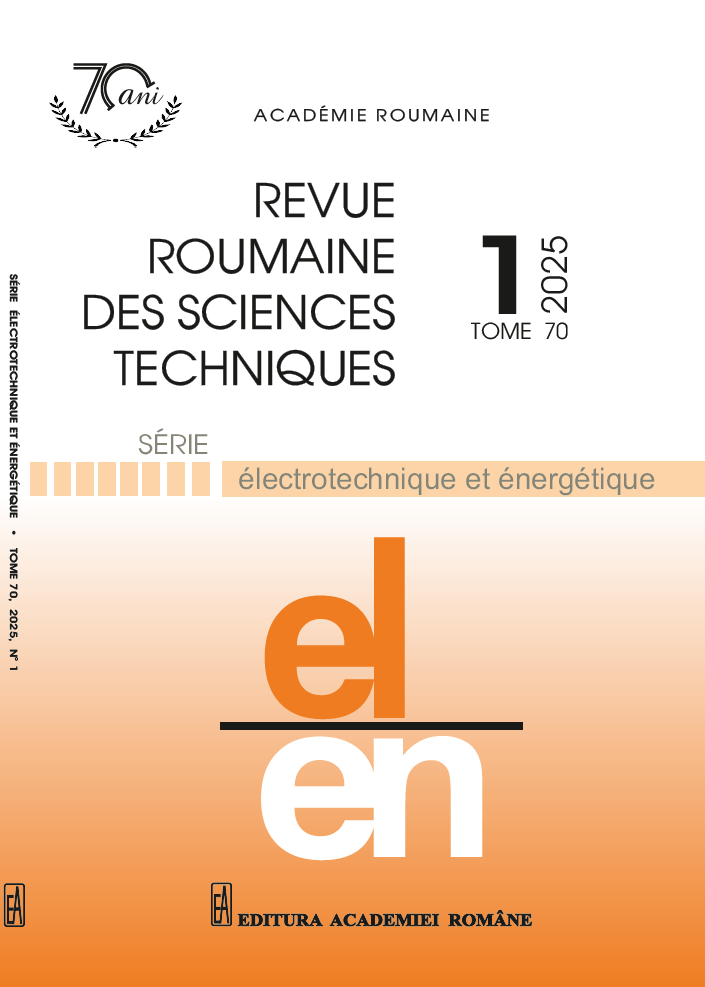A NOVEL DESIGN OF A PHOTOVOLTAIC SYSTEM BASED ON A LINEAR INDUCTION MOTOR AND RECIPROCATING PUMP
DOI:
https://doi.org/10.59277/RRST-EE.2025.1.1Keywords:
Photovoltaic, Linear induction motor, Reciprocating pump, Field-oriented control, Maximum power pointAbstract
This paper presents a novel approach to enhance the efficiency and performance of photovoltaic (PV)-water pumping systems by integrating a linear induction motor (LIM) with a double-acting reciprocating pump (DARP). The proposed system is designed to achieve direct linear motion without needing a gearbox, thereby reducing costs and improving overall efficiency. This study presents the equivalent circuit of the LIM, including the phenomena of end effects, which increases its complexity and makes control difficult. A field-oriented control (FOC) technique is suggested to achieve better motor efficiency and dynamic performance to overcome this issue. Besides, the model of PV cells in environmental conditions, such as solar irradiance and temperature, significantly influence the I-V characteristics of PV panels. The MPPT-based P&O method was implemented to maximize their output power. The simulation results checked and validated in the Matlab/Simulink software tool demonstrate that combining LIM motors with DARP pumps offers advantages over traditional rotary motor-centrifugal pumps. This confirms that it is a beneficial solution for cost-effective, eco-friendly, and efficient irrigation.
References
(1) H.K.V. Gadiraju, V.R. Barry, R.K. Jain, Improved performance of PV water pumping system using dynamic reconfiguration algorithm under partial shading conditions, CPSS Transactions on Power Electronics and Applications, 7, 2, pp. 206–215 (2022).
(2) L. Gevorkov, J.L. Domínguez-García, L.T. Romero. Review on solar photovoltaic-powered pumping systems, Energies, 16, 1, pp.94 (2023).
(3) R. Kahani, M. Jamil. M.T. Iqbal. An improved perturb and observed maximum power point tracking algorithm for photovoltaic power systems, Journal of Modern Power Systems and Clean Energy, 11, 4, pp. 1165–1175 (2023).
(4) H. Yeqing, N. Songlin, M. Kai, L. Fan, L. Lei, Static stress and modal analysis of water hydraulic reciprocating piston pump driven by the linear motor, International Conference on Fluid Power and Mechatronics (FPM), Harbin, China, pp. 914–917 (2015).
(5) R. Rajan, L.A.R. Krishna, S. Sreeja, Mathematical modelling and analysis of linear induction motor, IEEE International Power and Renewable Energy Conference (IPRECON), Kollam, India, pp. 1–6 (2022).
(6) A. Mousaei, M.B. Bannae Sharifian, N. Rostami, An improved predictive current control strategy of linear induction motor based on ultra-local model and extended state observer, 13th Power Electronics, Drive Systems and Technologies Conference (PEDSTC), Tehran, Iran, Islamic Republic of, pp. 12–18 (2022).
(7) P. Marcello, Direct field-oriented control of linear induction motors. Electric Power Systems Research, 89, pp. 11–22 (2021).
(8) M.R. Rezoug, R. Chenni, D. Taibi, Fuzzy logic-based perturb and observe algorithm with variable step of a reference voltage for solar permanent magnet synchronous motor drive system fed by direct-connected photovoltaic array, Energies, 11, 2, pp. 462 (2018).
(9) N. Kacimi, A. Idir, S. Grouni, MS. Boucherit, A new combined method for tracking the global maximum power point of photovoltaic systems, RRST-EE, 67, 3, pp. 349–54 (2022).
(10) S. Samah, M. Birane, K. Benmouiza, A comparative analysis of boost converter topologies for photovoltaic systems using MPPT (Po) and Beta methods under partial shading, RRST-EE, 68, 4, pp. 375–380 (2023).
(11) J. Duncan, Linear induction motor-equivalent-circuit model, IEE Proc. B, Electron. Power Appl., 130, 1, pp. 51–57 (1983).
(12) J.F. Gieras, G.E. Dawson, A.R. Eastham, A new longitudinal end effect factor for linear induction motor, IEEE Transactions on energy conversion, EC-2, 1, pp. 152–159 (1987).
(13) L. Khettache, R. Abdessemed, A new speed control approach of linear induction motor based on robust RST controller and model reference adaptive system estimator, International Journal of Engineering, 36, 4, pp. 630–639 (2023).
(14) L. Zhang, H. Obeid, S. Laghrouche, M. Cirrincione, Second order sliding mode observer of linear induction motor, IET Electric Power Applications, 13, 1, pp. 38–47 (2019).
(15) H.A. Hussain, H.A. Toliyat, A fault monitoring system for a reciprocating pump driven by a linear motor for oil pumping systems, IEEE Energy Conversion Congress and Exposition (ECCE), Cincinnati, OH, USA, pp. 4338–4344 (2017).
(16) K. Wang, Y. Li, Q. Ge, L. Shi, An improved indirect field-oriented control scheme for linear induction motor traction drives, IEEE-Transactions on Industrial Electronics, 65, 12, pp. 9928–9937 (2018).
(17) D.B. Jani, C. Chetan, J. Chauhan, Da. Baria, U. Barjod, J. Bangadiya, Performance investigation on double acting reciprocating pump, Applied Energy. 6, 4 pp. 14–17 (2019).
(18) G. Boyun, X. Liu, X. Tan, Transportation systems, Petroleum Production Engineering, Gulf Professional Publishing, pp. 275–325 (2017).
(19) C.F. Lieu, W.K. Chan, K.T. Ooi, Experimental investigation of the reciprocating ball pump (RBP), Medical Engineering & Physics, 34, pp. 1101– 1108 (2012).
(20) J. Pei, C. He, M. Lv, X. Huang, K. Shen, K. Bi, The valve motion characteristics of a reciprocating pump, Mech. Syst. Signal Process., 66–67, pp. 657–664 (2016).
(21) S. Pant, R.P. Saini, Solar water pumping system modelling and analysis using MATLAB/Simulink. IEEE Students Conference on Engineering & Systems (SCES), Prayagraj, India, pp. 1–6 (2020).
(22) 22. M. Errouha, S. Motahhir, Q. Combe, et al., Intelligent control of induction motor for photovoltaic water pumping system.SN Appl. Sci., 3, 777 (2021).
Downloads
Published
Issue
Section
License
Copyright (c) 2025 REVUE ROUMAINE DES SCIENCES TECHNIQUES — SÉRIE ÉLECTROTECHNIQUE ET ÉNERGÉTIQUE

This work is licensed under a Creative Commons Attribution-NonCommercial-NoDerivatives 4.0 International License.


